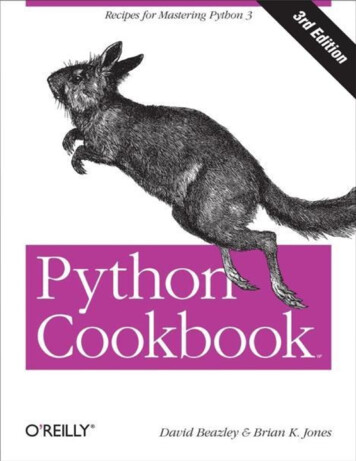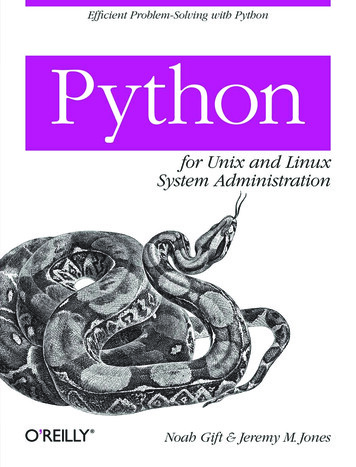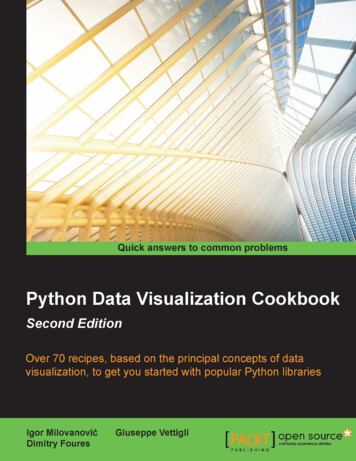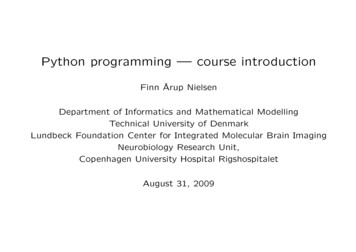
Transcription
Python CookbookDavid BeazleyBrian K. JonesBeijing Cambridge Farnham Köln Sebastopol Tokyo
Special Upgrade OfferIf you purchased this ebook directly from oreilly.com, you have the following benefits:DRM-free ebooks—use your ebooks across devices without restrictions or limitationsMultiple formats—use on your laptop, tablet, or phoneLifetime access, with free updatesDropbox syncing—your files, anywhereIf you purchased this ebook from another retailer, you can upgrade your ebook to take advantage of allthese benefits for just 4.99. Click here to access your ebook upgrade.Please note that upgrade offers are not available from sample content.
PrefaceSince 2008, the Python world has been watching the slow evolution of Python 3. It was always knownthat the adoption of Python 3 would likely take a long time. In fact, even at the time of this writing(2013), most working Python programmers continue to use Python 2 in production. A lot has beenmade about the fact that Python 3 is not backward compatible with past versions. To be sure,backward compatibility is an issue for anyone with an existing code base. However, if you shift yourview toward the future, you’ll find that Python 3 offers much more than meets the eye.Just as Python 3 is about the future, this edition of the Python Cookbook represents a major changeover past editions. First and foremost, this is meant to be a very forward looking book. All of therecipes have been written and tested with Python 3.3 without regard to past Python versions or the“old way” of doing things. In fact, many of the recipes will only work with Python 3.3 and above.Doing so may be a calculated risk, but the ultimate goal is to write a book of recipes based on the mostmodern tools and idioms possible. It is hoped that the recipes can serve as a guide for people writingnew code in Python 3 or those who hope to modernize existing code.Needless to say, writing a book of recipes in this style presents a certain editorial challenge. An onlinesearch for Python recipes returns literally thousands of useful recipes on sites such as ActiveState’sPython recipes or Stack Overflow. However, most of these recipes are steeped in history and the past.Besides being written almost exclusively for Python 2, they often contain workarounds and hacksrelated to differences between old versions of Python (e.g., version 2.3 versus 2.4). Moreover, theyoften use outdated techniques that have simply become a built-in feature of Python 3.3. Findingrecipes exclusively focused on Python 3 can be a bit more difficult.Rather than attempting to seek out Python 3-specific recipes, the topics of this book are merelyinspired by existing code and techniques. Using these ideas as a springboard, the writing is an originalwork that has been deliberately written with the most modern Python programming techniquespossible. Thus, it can serve as a reference for anyone who wants to write their code in a modern style.In choosing which recipes to include, there is a certain realization that it is simply impossible to writea book that covers every possible thing that someone might do with Python. Thus, a priority has beengiven to topics that focus on the core Python language as well as tasks that are common to a widevariety of application domains. In addition, many of the recipes aim to illustrate features that are newto Python 3 and more likely to be unknown to even experienced programmers using older versions.There is also a certain preference to recipes that illustrate a generally applicable programmingtechnique (i.e., programming patterns) as opposed to those that narrowly try to address a very specificpractical problem. Although certain third-party packages get coverage, a majority of the recipes focuson the core language and standard library.
Who This Book Is ForThis book is aimed at more experienced Python programmers who are looking to deepen theirunderstanding of the language and modern programming idioms. Much of the material focuses onsome of the more advanced techniques used by libraries, frameworks, and applications. Throughoutthe book, the recipes generally assume that the reader already has the necessary background tounderstand the topic at hand (e.g., general knowledge of computer science, data structures,complexity, systems programming, concurrency, C programming, etc.). Moreover, the recipes areoften just skeletons that aim to provide essential information for getting started, but which require thereader to do more research to fill in the details. As such, it is assumed that the reader knows how touse search engines and Python’s excellent online documentation.Many of the more advanced recipes will reward the reader’s patience with a much greater insight intohow Python actually works under the covers. You will learn new tricks and techniques that can beapplied to your own code.
Who This Book Is Not ForThis is not a book designed for beginners trying to learn Python for the first time. In fact, it alreadyassumes that you know the basics that might be taught in a Python tutorial or more introductory book.This book is also not designed to serve as a quick reference manual (e.g., quickly looking up thefunctions in a specific module). Instead, the book aims to focus on specific programming topics, showpossible solutions, and serve as a springboard for jumping into more advanced material you mightfind online or in a reference.
Conventions Used in This BookThe following typographical conventions are used in this book:ItalicIndicates new terms, URLs, email addresses, filenames, and file extensions.Constant widthUsed for program listings, as well as within paragraphs to refer to program elements such asvariable or function names, databases, data types, environment variables, statements, andkeywords.Constant width boldShows commands or other text that should be typed literally by the user.Constant width italicShows text that should be replaced with user-supplied values or by values determined by context.TIPThis icon signifies a tip, suggestion, or general note.WARNINGThis icon indicates a warning or caution.
Online Code ExamplesAlmost all of the code examples in this book are available online at http://github.com/dabeaz/pythoncookbook. The authors welcome bug fixes, improvements, and comments.
Using Code ExamplesThis book is here to help you get your job done. In general, if this book includes code examples, youmay use the code in this book in your programs and documentation. You do not need to contact us forpermission unless you’re reproducing a significant portion of the code. For example, writing aprogram that uses several chunks of code from this book does not require permission. Selling ordistributing a CD-ROM of examples from O’Reilly books does require permission. Answering aquestion by citing this book and quoting example code does not require permission. Incorporating asignificant amount of example code from this book into your product’s documentation does requirepermission.We appreciate, but do not require, attribution. An attribution usually includes the title, author,publisher, and ISBN. For example: Python Cookbook, 3rd edition, by David Beazley and Brian K.Jones (O’Reilly). Copyright 2013 David Beazley and Brian Jones, 978-1-449-34037-7.If you feel your use of code examples falls outside fair use or the permission given here, feel free tocontact us at permissions@oreilly.com.
Safari Books OnlineNOTESafari Books Online is an on-demand digital library that delivers expert content in both book and video form from the world’sleading authors in technology and business.Technology professionals, software developers, web designers, and business and creativeprofessionals use Safari Books Online as their primary resource for research, problem solving,learning, and certification training.Safari Books Online offers a range of product mixes and pricing programs for organizations,government agencies, and individuals. Subscribers have access to thousands of books, training videos,and prepublication manuscripts in one fully searchable database from publishers like O’Reilly Media,Prentice Hall Professional, Addison-Wesley Professional, Microsoft Press, Sams, Que, Peachpit Press,Focal Press, Cisco Press, John Wiley & Sons, Syngress, Morgan Kaufmann, IBM Redbooks, Packt,Adobe Press, FT Press, Apress, Manning, New Riders, McGraw-Hill, Jones & Bartlett, CourseTechnology, and dozens more. For more information about Safari Books Online, please visit us online.
How to Contact UsPlease address comments and questions concerning this book to the publisher:O’Reilly Media, Inc.1005 Gravenstein Highway NorthSebastopol, CA 95472800-998-9938 (in the United States or Canada)707-829-0515 (international or local)707-829-0104 (fax)We have a web page for this book, where we list errata, examples, and any additional information.You can access this page at http://oreil.ly/python cookbook 3e.To comment or ask technical questions about this book, send email to bookquestions@oreilly.com.For more information about our books, courses, conferences, and news, see our website athttp://www.oreilly.com.Find us on Facebook: http://facebook.com/oreillyFollow us on Twitter: http://twitter.com/oreillymediaWatch us on YouTube: http://www.youtube.com/oreillymedia
AcknowledgmentsWe would like to acknowledge the technical reviewers, Jake Vanderplas, Robert Kern, and AndreaCrotti, for their very helpful comments, as well as the general Python community for their support andencouragement. We would also like to thank the editors of the prior edition, Alex Martelli, AnnaRavenscroft, and David Ascher. Although this edition is newly written, the previous edition providedan initial framework for selecting the topics and recipes of interest. Last, but not least, we would liketo thank readers of the early release editions for their comments and suggestions for improvement.David Beazley’s AcknowledgmentsWriting a book is no small task. As such, I would like to thank my wife Paula and my two boys fortheir patience and support during this project. Much of the material in this book was derived fromcontent I developed teaching Python-related training classes over the last six years. Thus, I’d like tothank all of the students who have taken my courses and ultimately made this book possible. I’d alsolike to thank Ned Batchelder, Travis Oliphant, Peter Wang, Brian Van de Ven, Hugo Shi, RaymondHettinger, Michael Foord, and Daniel Klein for traveling to the four corners of the world to teachthese courses while I stayed home in Chicago to work on this project. Meghan Blanchette and RachelRoumeliotis of O’Reilly were also instrumental in seeing this project through to completion despitethe drama of several false starts and unforeseen delays. Last, but not least, I’d like to thank the Pythoncommunity for their continued support and putting up with my flights of diabolical fancy.David M. beazBrian Jones’ AcknowledgmentsI would like to thank both my coauthor, David Beazley, as well as Meghan Blanchette and RachelRoumeliotis of O’Reilly, for working with me on this project. I would also like to thank my amazingwife, Natasha, for her patience and encouragement in this project, and her support in all of myambitions. Most of all, I’d like to thank the Python community at large. Though I have contributed tothe support of various open source projects, languages, clubs, and the like, no work has been sogratifying and rewarding as that which has been in the service of the Python community.Brian K. com/bkjones
Chapter 1. Data Structures and AlgorithmsPython provides a variety of useful built-in data structures, such as lists, sets, and dictionaries. For themost part, the use of these structures is straightforward. However, common questions concerningsearching, sorting, ordering, and filtering often arise. Thus, the goal of this chapter is to discusscommon data structures and algorithms involving data. In addition, treatment is given to the variousdata structures contained in the collections module.
1.1. Unpacking a Sequence into Separate VariablesProblemYou have an N-element tuple or sequence that you would like to unpack into a collection of Nvariables.SolutionAny sequence (or iterable) can be unpacked into variables using a simple assignment operation. Theonly requirement is that the number of variables and structure match the sequence. For example: 4 5 p (4, 5)x, y pxy data [ 'ACME', 50, 91.1, (2012, 12, 21) ] name, shares, price, date data name'ACME' date(2012, 12, 21) name, shares, price, (year, mon, day) data name'ACME' year2012 mon12 day21 If there is a mismatch in the number of elements, you’ll get an error. For example: p (4, 5) x, y, z pTraceback (most recent call last):File " stdin ", line 1, in module ValueError: need more than 2 values to unpack DiscussionUnpacking actually works with any object that happens to be iterable, not just tuples or lists. Thisincludes strings, files, iterators, and generators. For example: 'H' 'e' 'o' s 'Hello'a, b, c, d, e sabeWhen unpacking, you may sometimes want to discard certain values. Python has no special syntax forthis, but you can often just pick a throwaway variable name for it. For example: data [ 'ACME', 50, 91.1, (2012, 12, 21) ] , shares, price, data shares50 price91.1 However, make sure that the variable name you pick isn’t being used for something else already.
1.2. Unpacking Elements from Iterables of Arbitrary LengthProblemYou need to unpack N elements from an iterable, but the iterable may be longer than N elements,causing a “too many values to unpack” exception.SolutionPython “star expressions” can be used to address this problem. For example, suppose you run a courseand decide at the end of the semester that you’re going to drop the first and last homework grades, andonly average the rest of them. If there are only four assignments, maybe you simply unpack all four,but what if there are 24? A star expression makes it easy:def drop first last(grades):first, *middle, last gradesreturn avg(middle)As another use case, suppose you have user records that consist of a name and email address, followedby an arbitrary number of phone numbers. You could unpack the records like this: record ('Dave', 'dave@example.com', '773-555-1212', '847-555-1212') name, email, *phone numbers user record name'Dave' email'dave@example.com' phone numbers['773-555-1212', '847-555-1212'] It’s worth noting that the phone numbers variable will always be a list, regardless of how many phonenumbers are unpacked (including none). Thus, any code that uses phone numbers won’t have toaccount for the possibility that it might not be a list or perform any kind of additional type checking.The starred variable can also be the first one in the list. For example, say you have a sequence ofvalues representing your company’s sales figures for the last eight quarters. If you want to see how themost recent quarter stacks up to the average of the first seven, you could do something like this:*trailing qtrs, current qtr sales recordtrailing avg sum(trailing qtrs) / len(trailing qtrs)return avg comparison(trailing avg, current qtr)Here’s a view of the operation from the Python interpreter: *trailing, current [10, 8, 7, 1, 9, 5, 10, 3] trailing[10, 8, 7, 1, 9, 5, 10] current3DiscussionExtended iterable unpacking is tailor-made for unpacking iterables of unknown or arbitrary length.Oftentimes, these iterables have some known component or pattern in their construction (e.g.“everything after element 1 is a phone number”), and star unpacking lets the developer leverage thosepatterns easily instead of performing acrobatics to get at the relevant elements in the iterable.It is worth noting that the star syntax can be especially useful when iterating over a sequence of tuplesof varying length. For example, perhaps a sequence of tagged tuples:records [('foo', 1, 2),('bar', 'hello'),('foo', 3, 4),]def do foo(x, y):print('foo', x, y)
def do bar(s):print('bar', s)for tag, *args in records:if tag 'foo':do foo(*args)elif tag 'bar':do bar(*args)Star unpacking can also be useful when combined with certain kinds of string processing operations,such as splitting. For example: line 'nobody:*:-2:-2:Unprivileged User:/var/empty:/usr/bin/false' uname, *fields, homedir, sh line.split(':') uname'nobody' homedir'/var/empty' sh'/usr/bin/false' Sometimes you might want to unpack values and throw them away. You can’t just specify a bare *when unpacking, but you could use a common throwaway variable name, such as or ign (ignored).For example: record ('ACME', 50, 123.45, (12, 18, 2012)) name, * , (* , year) record name'ACME' year2012 There is a certain similarity between star unpacking and list-processing features of various functionallanguages. For example, if you have a list, you can easily split it into head and tail components likethis: items [1, 10, 7, 4, 5, 9] head, *tail items head1 tail[10, 7, 4, 5, 9] One could imagine writing functions that perform such splitting in order to carry out some kind ofclever recursive algorithm. For example: def sum(items):.head, *tail items.return head sum(tail) if tail else head. sum(items)36 However, be aware that recursion really isn’t a strong Python feature due to the inherent recursionlimit. Thus, this last example might be nothing more than an academic curiosity in practice.
1.3. Keeping the Last N ItemsProblemYou want to keep a limited history of the last few items seen during iteration or during some otherkind of processing.SolutionKeeping a limited history is a perfect use for a collections.deque. For example, the following codeperforms a simple text match on a sequence of lines and yields the matching line along with theprevious N lines of context when found:from collections import dequedef search(lines, pattern, history 5):previous lines deque(maxlen history)for line in lines:if pattern in line:yield line, previous linesprevious lines.append(line)# Example use on a fileif name ' main ':with open('somefile.txt') as f:for line, prevlines in search(f, 'python', 5):for pline in prevlines:print(pline, end '')print(line, end '')print('-'*20)DiscussionWhen writing code to search for items, it is common to use a generator function involving yield, asshown in this recipe’s solution. This decouples the process of searching from the code that uses theresults. If you’re new to generators, see Recipe 4.3.Using deque(maxlen N) creates a fixed-sized queue. When new items are added and the queue is full,the oldest item is automatically removed. For example: q deque(maxlen 3) q.append(1) q.append(2) q.append(3) qdeque([1, 2, 3], maxlen 3) q.append(4) qdeque([2, 3, 4], maxlen 3) q.append(5) qdeque([3, 4, 5], maxlen 3)Although you could manually perform such operations on a list (e.g., appending, deleting, etc.), thequeue solution is far more elegant and runs a lot faster.More generally, a deque can be used whenever you need a simple queue structure. If you don’t give ita maximum size, you get an unbounded queue that lets you append and pop items on either end. Forexample: q deque() q.append(1) q.append(2) q.append(3) qdeque([1, 2, 3]) q.appendleft(4) qdeque([4, 1, 2, 3]) q.pop()3
qdeque([4, 1, 2]) q.popleft()4Adding or popping items from either end of a queue has O(1) complexity. This is unlike a list whereinserting or removing items from the front of the list is O(N).
1.4. Finding the Largest or Smallest N ItemsProblemYou want to make a list of the largest or smallest N items in a collection.SolutionTh e heapq module has two functions—nlargest() and nsmallest()—that do exactly what youwant. For example:import heapqnums [1, 8, 2, 23, 7, -4, 18, 23, 42, 37, 2]print(heapq.nlargest(3, nums)) # Prints [42, 37, 23]print(heapq.nsmallest(3, nums)) # Prints [-4, 1, 2]Both functions also accept a key parameter that allows them to be used with more complicated datastructures. For example:portfolio 'IBM', 'shares': 100, 'price': 91.1},'AAPL', 'shares': 50, 'price': 543.22},'FB', 'shares': 200, 'price': 21.09},'HPQ', 'shares': 35, 'price': 31.75},'YHOO', 'shares': 45, 'price': 16.35},'ACME', 'shares': 75, 'price': 115.65}cheap heapq.nsmallest(3, portfolio, key lambda s: s['price'])expensive heapq.nlargest(3, portfolio, key lambda s: s['price'])DiscussionIf you are looking for the N smallest or largest items and N is small compared to the overall size ofthe collection, these functions provide superior performance. Underneath the covers, they work byfirst converting the data into a list where items are ordered as a heap. For example: nums [1, 8, 2, 23, 7, -4, 18, 23, 42, 37, 2] import heapq heap list(nums) heapq.heapify(heap) heap[-4, 2, 1, 23, 7, 2, 18, 23, 42, 37, 8] The most important feature of a heap is that heap[0] is always the smallest item. Moreover,subsequent items can be easily found using the heapq.heappop() method, which pops off the firstitem and replaces it with the next smallest item (an operation that requires O(log N) operations whereN is the size of the heap). For example, to find the three smallest items, you would do this: heapq.heappop(heap)-4 heapq.heappop(heap)1 heapq.heappop(heap)2The nlargest() and nsmallest() functions are most appropriate if you are trying to find a relativelysmall number of items. If you are simply trying to find the single smallest or largest item (N 1), it isfaster to use min() and max(). Similarly, if N is about the same size as the collection itself, it isusually faster to sort it first and take a slice (i.e., use sorted(items)[:N] or sorted(items)[-N:]).It should be noted that the actual implementation of nlargest() and nsmallest() is adaptive in howit operates and will carry out some of these optimizations on your behalf (e.g., using sorting if N isclose to the same size as the input).Although it’s not necessary to use this recipe, the implementation of a heap is an interesting andworthwhile subject of study. This can usually be found in any decent book on algorithms and data
structures. The documentation for the heapq module also discusses the underlying implementationdetails.
1.5. Implementing a Priority QueueProblemYou want to implement a queue that sorts items by a given priority and always returns the item withthe highest priority on each pop operation.SolutionThe following class uses the heapq module to implement a simple priority queue:import heapqclass PriorityQueue:def init (self):self. queue []self. index 0def push(self, item, priority):heapq.heappush(self. queue, (-priority, self. index, item))self. index 1def pop(self):return heapq.heappop(self. queue)[-1]Here is an example of how it might be used: class Item:.def init (self, name):.self.name name.def repr (self):.return 'Item({!r})'.format(self.name). q PriorityQueue() q.push(Item('foo'), 1) q.push(Item('bar'), 5) q.push(Item('spam'), 4) q.push(Item('grok'), 1) q.pop()Item('bar') q.pop()Item('spam') q.pop()Item('foo') q.pop()Item('grok') Observe how the first pop() operation returned the item with the highest priority. Also observe howthe two items with the same priority (foo and grok) were returned in the same order in which theywere inserted into the queue.DiscussionThe core of this recipe concerns the use of the heapq module. The functions heapq.heappush() andheapq.heappop() insert and remove items from a list queue in a way such that the first item in thelist has the smallest priority (as discussed in Recipe 1.4). The heappop() method always returns the“smallest” item, so that is the key to making the queue pop the correct items. Moreover, since thepush and pop operations have O(log N) complexity where N is the number of items in the heap, theyare fairly efficient even for fairly large values of N.In this recipe, the queue consists of tuples of the form (-priority, index, item). The priorityvalue is negated to get the queue to sort items from highest priority to lowest priority. This is oppositeof the normal heap ordering, which sorts from lowest to highest value.The role of the index variable is to properly order items with the same priority level. By keeping aconstantly increasing index, the items will be sorted according to the order in which they wereinserted. However, the index also serves an important role in making the comparison operations work
for items that have the same priority level.To elaborate on that, instances of Item in the example can’t be ordered. For example: a Item('foo') b Item('bar') a bTraceback (most recent call last):File " stdin ", line 1, in module TypeError: unorderable types: Item() Item() If you make (priority, item) tuples, they can be compared as long as the priorities are different.However, if two tuples with equal priorities are compared, the comparison fails as before. Forexample: a (1, Item('foo')) b (5, Item('bar')) a bTrue c (1, Item('grok')) a cTraceback (most recent call last):File " stdin ", line 1, in module TypeError: unorderable types: Item() Item() By introducing the extra index and making (priority, index, item) tuples, you avoid this problementirely since no two tuples will ever have the same value for index (and Python never bothers tocompare the remaining tuple values once the result of comparison can be determined): a b c aTrue aTrue (1, 0, Item('foo'))(5, 1, Item('bar'))(1, 2, Item('grok'))b cIf you want to use this queue for communication between threads, you need to add appropriate lockingand signaling. See Recipe 12.3 for an example of how to do this.The documentation for the heapq module has further examples and discussion concerning the theoryand implementation of heaps.
1.6. Mapping Keys to Multiple Values in a DictionaryProblemYou want to make a dictionary that maps keys to more than one value (a so-called “multidict”).SolutionA dictionary is a mapping where each key is mapped to a single value. If you want to map keys tomultiple values, you need to store the multiple values in another container such as a list or set. Forexample, you might make dictionaries like this:d {'a' : [1, 2, 3],'b' : [4, 5]}e {'a' : {1, 2, 3},'b' : {4, 5}}The choice of whether or not to use lists or sets depends on intended use. Use a list if you want topreserve the insertion order of the items. Use a set if you want to eliminate duplicates (and don’t careabout the order).To easily construct such dictionaries, you can use defaultdict in the collections module. A featureof defaultdict is that it automatically initializes the first value so you can simply focus on addingitems. For example:from collections import defaultdictd ['b'].append(4).d dd(4).One caution with defaultdict is that it will automatically create dictionary entries for keys accessedlater on (even if they aren’t currently found in the dictionary). If you don’t want this behavior, youmight use setdefault() on an ordinary dictionary instead. For example:d {}# A regular dictionaryd.setdefault('a', []).append(1)d.setdefault('a', []).append(2)d.setdefault('b', []).append(4).However, many programmers find setdefault() to be a little unnatural—not to mention the fact thatit always creates a new instance of the initial value on each invocation (the empty list [] in theexample).DiscussionIn principle, constructing a multivalued dictionary is simple. However, initialization of the first valuecan be messy if you try to do it yourself. For example, you might have code that looks like this:d {}for key, value in pairs:if key not in d:d[key] []d[key].append(value)Using a defaultdict simply leads to much cleaner code:
d defaultdict(list)for key, value in pairs:d[key].append(value)This recipe is strongly related to the problem of grouping records together in data processingproblems. See Recipe 1.15 for an example.
1.7. Keeping Dictionaries in OrderProblemYou want to create a dictionary, and you also want to control the order of items when iterating orserializing.SolutionTo control the order of items in a dictionary, you can use an OrderedDict from the collectionsmodule. It exactly preserves the original insertion order of data when iterating. For example:from collections import OrderedDictd OrderedDict()d['foo'] 1d['bar'] 2d['spam'] 3d['grok'] 4# Outputs "foo 1", "bar 2", "spam 3", "grok 4"for key in d:print(key, d[key])An OrderedDict can be particularly useful when you want to build a mapping that you may want tolater serialize or encode into a different format. For example, if you want to precisely control theorder of fields appearing in a JSON encoding, first building the data in an OrderedDict will do thetrick: import json json.dumps(d)'{"foo": 1, "bar": 2, "spam": 3, "grok": 4}' DiscussionAn OrderedDict internally maintains a doubly linked list that orders the keys according to insertionorder. When a new item is first inserted, it is placed at the end of this list. Subsequent reassignment ofan existing key doesn’t change the order.Be aware that the size of an OrderedDict is more than twice as large as a normal dictionary due to theextra linked list that’s created. Thus, if you are going to build a data structure involving a largenumber of OrderedDict instances (e.g., reading 100,000 lines of a CSV file into a list of OrderedD
Just as Python 3 is about the future, this edition of the Python Cookbook represents a major change over past editions. First and foremost, this is meant to be a very forward looking book. All of the recipes have been written and tested with Python 3.3 without regard to past Python versions or the "old way" of doing things.










